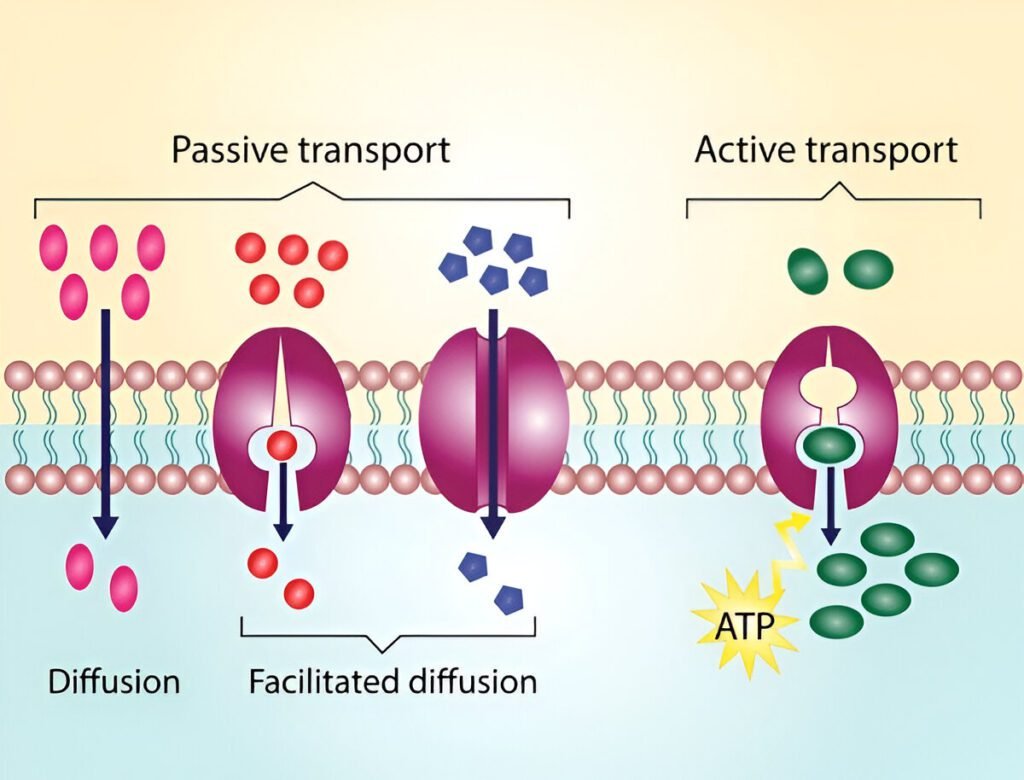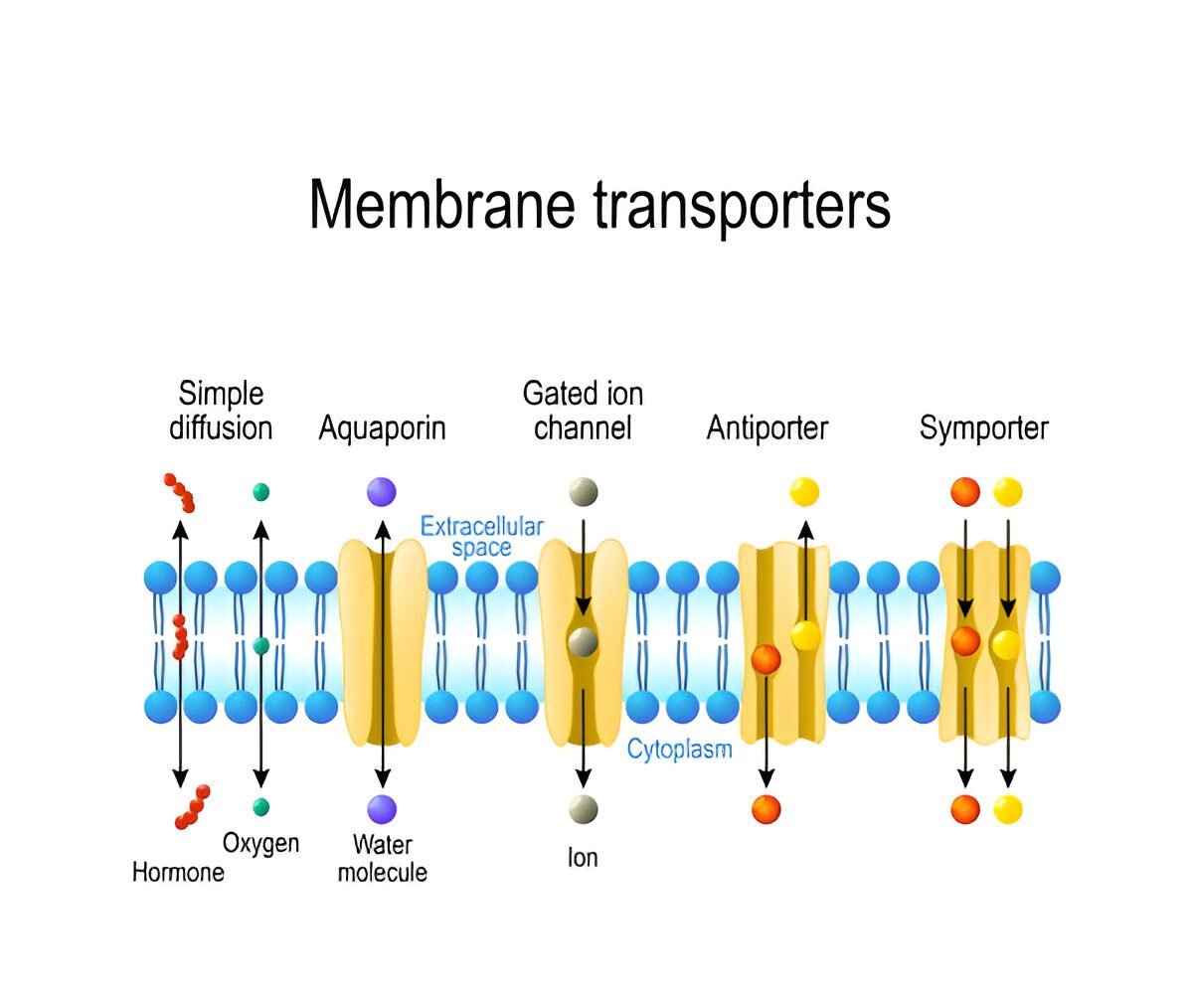
Cell Membrane Transport: Types and Functions
The cell membrane, also known as the plasma membrane, is a selective barrier that regulates the transport of substances in and out of the cell. This ability to regulate transport is essential for maintaining homeostasis, enabling communication, and supporting the overall functionality of the cell. The mechanisms by which substances move across the cell membrane can be categorized into passive transport, active transport, and bulk transport. Below, we delve into these types in detail with examples and additional information.
1. Passive Transport
Passive transport involves the movement of substances across the cell membrane without the expenditure of energy (ATP). Substances move along their concentration gradient, from an area of high concentration to an area of low concentration.
Types of Passive Transport:
- Simple Diffusion:
Involves the movement of small, nonpolar molecules directly through the lipid bilayer. Examples include:
- Oxygen (O2): Diffuses into cells during respiration.
- Carbon dioxide (CO2): Diffuses out of cells as a waste product.
Important Note: The rate of diffusion depends on factors like temperature, membrane permeability, and the concentration gradient.
- Facilitated Diffusion:
Larger or polar molecules that cannot pass through the lipid bilayer use protein channels or carriers. Examples include:
- Glucose: Transported by glucose transporters (e.g., GLUT1 in red blood cells).
- Ions: Move through ion channels, such as potassium (K+) channels in neurons.
- Osmosis:
The diffusion of water molecules through a semipermeable membrane. Water moves from an area of low solute concentration to an area of high solute concentration. Examples include:
- Plant Cells: Water enters root cells via osmosis, providing turgor pressure.
- Red Blood Cells: Swell or shrink in hypotonic or hypertonic solutions, respectively.
Key Feature: Passive transport does not require energy.
2. Active Transport
Active transport involves the movement of substances against their concentration gradient, from an area of low concentration to an area of high concentration. This process requires energy in the form of ATP and specialized transport proteins.
Types of Active Transport:
- Primary Active Transport:
Directly uses ATP to pump molecules across the membrane. Example:
- Sodium-Potassium Pump (Na+/K+ Pump): Maintains the electrochemical gradient in nerve and muscle cells by pumping 3 Na+ ions out and 2 K+ ions into the cell.
- Secondary Active Transport (Cotransport):
Uses the energy stored in an ion gradient created by primary active transport to move another substance. Examples:
- Symport: Both substances move in the same direction (e.g., glucose and sodium in intestinal cells).
- Antiport: Substances move in opposite directions (e.g., sodium-calcium exchanger).
Key Feature: Active transport requires energy and ensures essential molecules are concentrated within the cell.
3. Bulk Transport
Bulk transport is a type of active transport that involves the movement of large molecules or particles into or out of the cell via vesicles. This process is energy-dependent.
Types of Bulk Transport:
- Endocytosis:
The cell engulfs substances by forming vesicles from the plasma membrane. Types of endocytosis include:
- Phagocytosis: Engulfing large particles, such as white blood cells engulfing bacteria.
- Pinocytosis: Engulfing liquids and dissolved solutes.
- Receptor-Mediated Endocytosis: Specific molecules bind to receptors before being internalized (e.g., LDL cholesterol uptake).
- Exocytosis:
The release of substances from the cell via vesicles that fuse with the membrane. Example:
- Hormone Secretion: Insulin released by pancreatic cells.
4. Ion Channels and Electrogenic Transport
Ion channels are specialized proteins that allow the selective movement of ions across the membrane. This movement can be either passive or active.
- Voltage-Gated Channels: Open in response to changes in membrane potential (e.g., sodium channels in neurons).
- Ligand-Gated Channels: Open when a specific molecule binds to the channel (e.g., acetylcholine receptors in synapses).
Functions of Membrane Transport
- Maintains Homeostasis: Regulates ion balance and nutrient levels within the cell.
- Facilitates Communication: Enables signaling molecules to enter or exit the cell for cell-to-cell communication.
- Supports Energy Production: Ion gradients drive ATP synthesis in mitochondria.
- Ensures Nutrient Uptake: Facilitates absorption of glucose, amino acids, and other essential molecules.
- Expels Waste: Removes toxic byproducts of metabolism through active or passive mechanisms.
Conclusion
Cell membrane transport is a complex and highly regulated process that is vital for maintaining cellular function and homeostasis. By understanding the different transport mechanisms and their roles, we gain a deeper insight into the inner workings of cells and their



